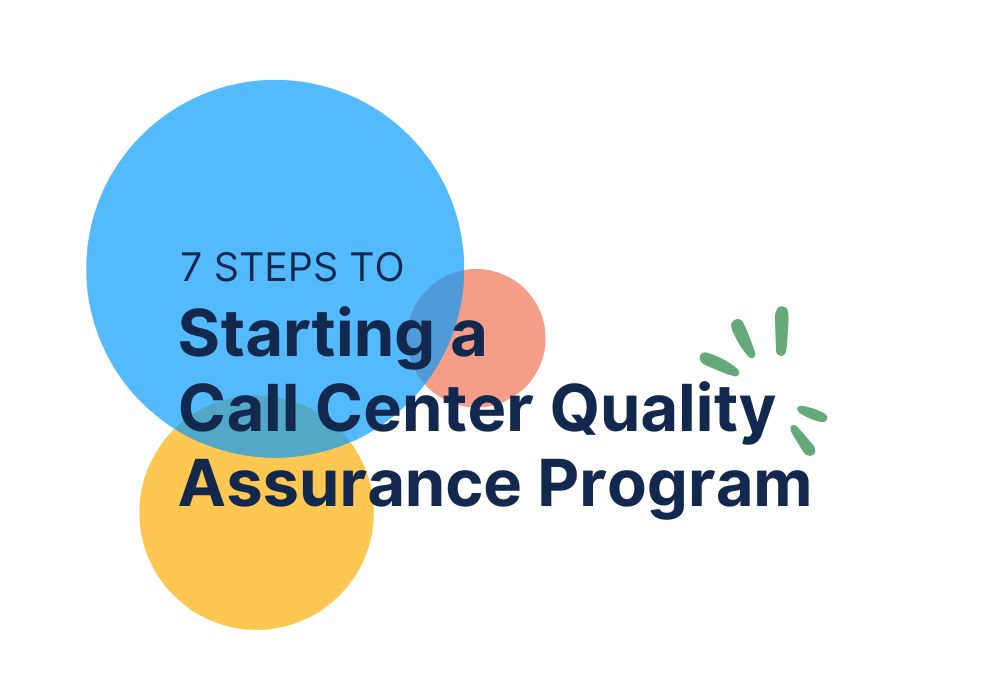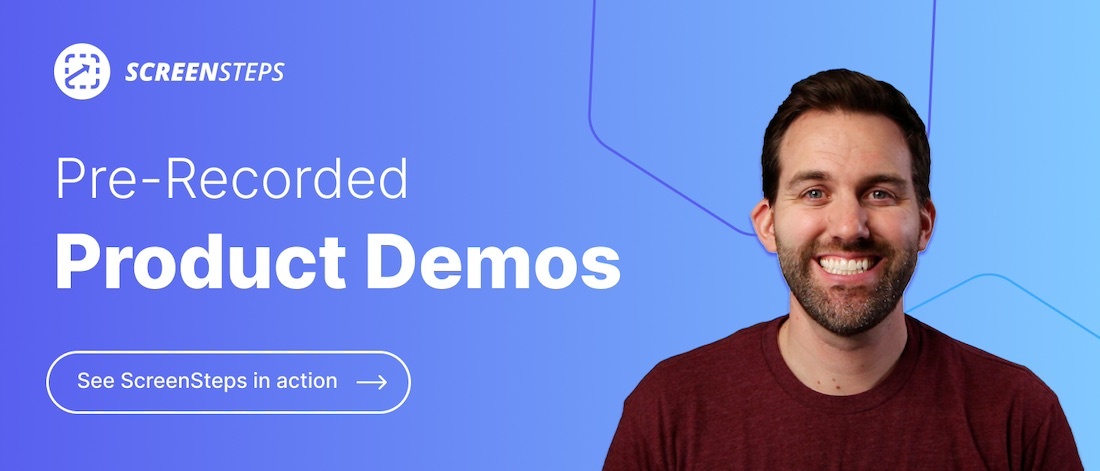7 Steps to Starting a Call Center Quality Assurance Program
You could be launching a new call center. Or maybe your call center is growing. Maybe your customer satisfaction score (CSAT) is lower than you want. Alternatively (and unfortunately), maybe you’ve had a larger number of escalations or complaints than you care to admit.
Either way, you’ve come to the realization — it’s time to create a quality assurance (QA) program.
These situations can be discouraging, confusing, and intimidating. While building a QA program for your call center can feel like a Herculean challenge, it is an exciting opportunity for your call center.
As the Director of Transformational Services at ScreenSteps — knowledge base software that supports call center documentation and agent performance — I’ve worked with call center leaders to document their procedures in a way that reflects the company’s QA expectations.
To do that, the company first needed a quality assurance program. Here are seven steps to help you create a QA program for your call center.
While these steps could be taken in consecutive order as listed, they don’t have to be. Some of these steps can overlap or be switched around.
Step 1: Decide on your QA standards
This first step is critical. Here you are defining your goals for your call center agents and how they handle calls.
One of the main problems I’ve seen when working with call centers is that the leaders don’t know how they want their interactions to go. They don’t have one “ideal call” that they want every agent to replicate.
In this first step, gather your leaders and subject matter experts. Discuss: “What does the perfect call sound like?” It is your QA checklist. These are must-have elements of the perfect call. This refers to different elements of the call, including:
- A warm greeting
- Professional tone
- Taking control of the call
- Identifying the problem
- Coming up with the solution
- Summarizing the solution
- Closing the call
If you want things to go smoothly, you need to come up with one way for everyone to do things.
Whatever you decide in this discussion will help you create a call center scorecard.
Determine KPIs and metrics
Your QA evaluations will be one way that you measure the success of your QA program. You’ll also want to track and analyze other call center metrics that affect QA. Some key performance indicators (KPIs) for your call center include:
- QA score
- Customer satisfaction score (CSAT)
- First call resolution
- Average abandonment rate
- Average hold time
- NPS score
Step 2: Create an execution plan
Once you’ve established your expectations for a call, you can create a plan to implement and maintain quality assurance in your call center.
To execute a QA program, there are different elements of QA that you need to plan out. Step 2 is broken down into four sub-steps for creating a plan to launch a QA program.
I. Assign roles and responsibilities
Before anything can get done, your team needs to know who is in charge of what. Do you even have a team? Or is it one person heading and executing the program?
Everyone on the QA team needs to know what they are in charge of and what their deadlines are.
Some roles and responsibilities you will want to delegate include:
- Who owns your QA program (QA manager)?
- Who’s in charge of training?
- Who can conduct QA assessments?
II. How to perform QA evaluations
How are evaluations going to be completed? How frequently will your call center agents be evaluated?
From your call standards meeting, you should have a QA scorecard. You will use this to evaluate your agents and give them a QA score. As far as how you go about evaluations, you can review call recordings or you can listen to live calls.
Set a timeline for how often you will assess reps. The frequency will depend on your business. Typically, businesses with important compliance restrictions will test more frequently. However, QA is an ongoing process in a call center that never truly stops.III. QA resources for agents
Designate people to create resources for your call center agents that align with your QA scorecards. If you want to improve your QA scores, you need agents to have access to the information they need. Your reps should have resources that mirror your QA checklist.
IV. Training
Do an audit of how calls are going. Compare that to your QA scorecard and the standards you’ve created.
Develop a training program around your QA standards. This can help fill in the gaps you discover from your call audit. Teach your reps how they can achieve a perfect QA score. Train them on how to access and use your QA resources.
Step 3: Get the tools you need
This step goes hand-in-hand with step 2. There are certain tools you’ll need in order to execute your QA plan. You’ll need these tools in place to launch a QA program in your call center.
For the different aspects of your QA program, you’ll need different tools. Some common tools you could use in your technology stack include:
- Call recording
- Integrated voice response (IVR)
- CRM-integrated customer service software
- Knowledge management system (i.e. call scripting software, document library, knowledge base, etc.)
- Learning management system (LMS)
Step 4: Document your policies and procedures
In step 2, I shared how you need to select someone (or a team) to create resources that align with your QA scorecard. These resources are your policies on procedures that incorporate the QA best practices that you will be accessing.
There are many different resources you can create to support your agents when they are on a call. You want resources that are easy to skim so that agents don’t need to put the caller on hold to learn more information (and increase your average handle time). Some of these resources include:
- Checklists
- Call flows
- Call center scripts
- Policies
- Standard operating procedures (SOPs)
- Reference sheet
Perform a gap analysis
As you decide which content to create for your call center agents, perform a gap analysis.
Which information are you missing? Do your agents have all the information they need at their fingertips to achieve a perfect QA score?
Step 5: Train agents on how to use the documentation
You already have someone designated to create the QA training program. Now, you need to train your call center reps on the new QA program.
And, now that you’ve created these resources, you want your agents to use them. There is no point in creating the documents and then hiding them in folders that your reps can’t access. That’s a waste of time and energy.
Teach your reps how to find the guides that they need as well as how to follow the guides. Do you use italics to represent when they should say something to the customer and regular text to represent when they need to do a task? Teach them that.
Use scenario-based training to role-play different calls agents will handle. Have them use the guides as they role-play these scenarios.
Step 6: Implement your QA plan
Once you have your resources ready and training complete, it is time to put your QA plan into action. By that, I mean it is time to start assessing how your call center agents are serving your callers.
Luckily, you’ve already set up a schedule for when and who to evaluate. Plus, you have your QA scorecard to measure your agents’ strengths and weaknesses.
You may run into some kinks, but that’s okay. Make adjustments as you need to.
Continue to send reminders to your agents about QA expectations. This will help keep them on track as training gets farther away in their rearview mirror.
Step 7: Monitor results and feedback
Once you’ve launched the QA program, it’s not over. Just like QA evaluations are an ongoing process, so is monitoring your results and feedback.
Evaluate your QA scores. What do the results tell you? Where do you need more training? Who needs additional help and how will you help them? Pay attention to key metrics:
- Average handle time
- CSAT scores
- First call resolution
- Average hold time
- NPS score
Ask for and listen to feedback from your call center agents. They will know if something is missing in the QA evaluations or if they need additional resources to help them achieve better QA scores.
Once you’ve listened to feedback, you will learn ways you can improve your guides. Update your guides and QA scorecard as needed. After all, quality assurance is constantly evolving with changes to your company and processes.
🔎 Related: How To Improve Call Center Performance Metrics and KPIs (4 Ways)
Put QA resources where your agents can access them easily and quickly
It takes a lot of discussions and planning to create a call center quality assurance program. But, it is worth it. Having a QA program in your call center will help provide a consistent customer experience, increase your call center KPIs/metrics, and improve employee performance.
As you create your QA program, it is critical that you don’t forget to provide your call center agents with the resources they need to succeed. You’ll need a central hub — like a knowledge base — to organize your documents.
With a ScreenSteps knowledge base, your call center agents don’t need to put their callers on hold. That’s because they can seamlessly pull up the resources they need in as few as two clicks. They don’t need to leave the screen they are working in because of contextual help.
Plus, it is fast and easy to write and update call flows, policies, and other resources with the ScreenSteps content creation tools.
See how ScreenSteps can help you create, organize, and share your call center QA resources. Watch these pre-recorded demo videos to see the tools in action.


.png)
